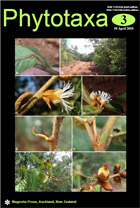Abstract
Philadelphus mexicanus Schlechtendal (1839: 418).
Protologue: “Colitur Jalapae et in sepibus sponte quasi crescit Majo flor (Schiede), ad Oajaca (Mühlenpfordt), ad Mexico
(hb. Lehm.)”
Lectotype (designated here): Mexico, Schiede s.n., anno 1829 (HAL-098628!, duplicate BM-000956236!).
Three samples (syntypes) all from Mexico are listed in the original publication: one collected by Schiede, one by Mühlenpfordt and one from the herbarium of Lehmann. Because the Schiede collection is the first one listed in the protologue, it is chosen here as the lectotype. The specimen in Halle is preferred, because D.F.L. von Schlechtendal was professor of botany and director of the Botanical Garden of Halle University at the time of description of this species (Staffleu & Cowan 1967: 190-191).
yntyp|�iJ` 0�n. (K!), is also the
holotype of Impatiens sultanii Hooker (1882: t. 6643), a synonym.
The well-known bedding plant ‘busy lizzie’, Impatiens walleriana (Balsaminaceae), is a species occurring naturally in East Africa, where it can be found locally abundant in Kenya, Tanzania and Mozambique. It is frequently associated with wet or humid habitats and can thus be found near streams, waterfalls and in gorges or in the understorey of wet forests. Elsewhere in the tropics and subtropics the species can commonly be found naturalised along roads, in secondary forests and other disturbed habitats, where it can form dominant stands, competing out other species (Richardson et al. 2000, Tabak & Wettenberg 2008).

